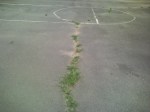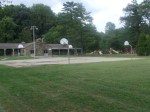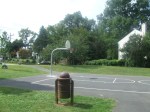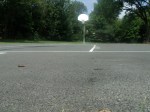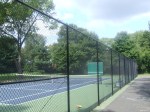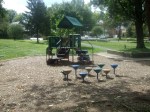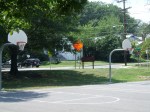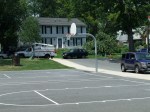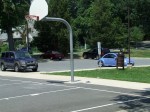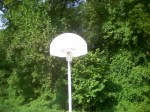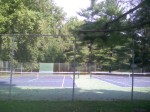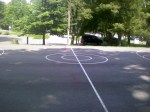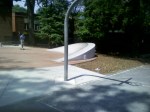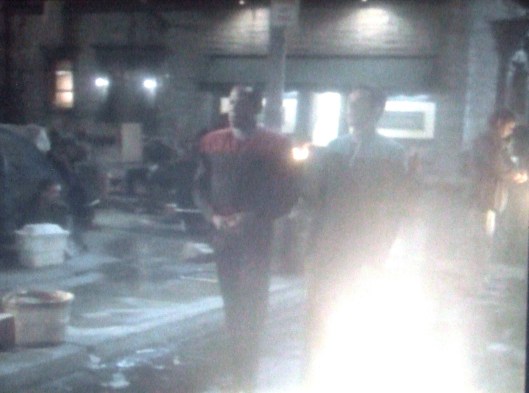Tags
Basketball Courts, Belle Ziegler Park, Budget, Chevy Chase, Facilities, Facilities Management, Forest Glen Park, Jessup-Blair Park, M-NCPPC, Maintenance, Maryland-National Capital Park and Planning Commission, Meadowbrook Park, Montgomery County MD, Montgomery County Parks, Montgomery Hills Park, Playgrounds, Renovations, Silver Spring, Silver Spring Intermediate Park, Sligo-Dennis Ave Park, Takoma Park, Tennis Courts, Woodland Park
Montgomery County Parks has done a poor job of maintaining its facilities. Especially its outdoor basketball courts, where the department has spared precious little funds for their maintenance and renovation. Even in cases where renovations have occurred, some courts remain substandard. Others are so poorly maintained, though, that they have fallen into non-use.
Given the growth in the county’s population over the previous decade – particularly of working-class Latino immigrants – and the growth in obesity rates, Montgomery County Parks is taking a risk with its poor maintenance and renovation record. The risk: that residents will assume – rightly or wrongly – that the county believes that certain parks and certain basketball courts aren’t worth the time and money to fix for fear of certain kinds of people.
Montgomery County, Maryland, part of suburban Washington, DC, is one of the ten richest counties in the United States, at least according to the US Census Bureau. As part of the Maryland-National Capital Park and Planning Commission (M-NCPPC) for Montgomery and Prince George’s counties, Montgomery County Parks has worked with an annual average budget of $121 million over the past five years for its dozens of parks and facilities. Yet in all eight parks that are part of this article, visited between July and September, the outdoor basketball courts had numerous deficiencies (see pictures attached). Montgomery County Parks has not responded to inquiries on this topic.
At Meadowbrook Park in Chevy Chase, there were two full basketball courts with an asphalt surface. That surface, however, was one that was weather-beaten and had undergone a series of patchwork repairs that from all appearances occurred more than a decade ago. It had rained the day before, and the multiple puddles on the court had yet to dry up or drain. There were muddy footprints and tire tracks on one side of the court. The faded-white backboards had severely rusted mounts and piping. One of the hoops had twisted about 45 degrees to the right, so off-centered that it would need to be replaced completely. Not more than fifteen yards away from the unfenced outdoor courts was a group of four tennis courts, well maintained and properly gated, with lights that can be turned on after sundown for night-time matches.
At Jessup-Blair Park on the Silver Spring-Washington, DC border, a renovation that had occurred in 2006-07 had already shown signs of disintegration. The surface of the renovated full court and half-court was the same as the surface of the tennis court, a hard but modified green asphalt surface. There were grass-filled holes and cracks in various spots throughout the basketball court, likely from the stress of full-court basketball games and the constant dribbling of basketballs.
The full court at Jessup-Blair was easily the largest one of the eight examined here, regulation size, with sixteen paces between mid-court and the three-point lines of each half court, and twenty-one paces between the three-point line and the hoop. The hoops themselves measured 10.5 feet off the ground, set up no doubt to discourage dunking, but a bit of a challenge for anyone attempting a jump-shot. Outdoor courts at other parks, including Montgomery Hills, Sligo-Dennis Avenue and Woodland, varied between six and thirteen paces between mid-court and each half-court’s three-point-line, and between twelve and eighteen paces between the three-point-line and each hoop. All had sloping issues, in which the court tilted lower or higher from one side to another.
Forest Glen Park’s basketball court was also in critical need of repair. The court was full of potholes, and grass had grown through the numerous deep cracks in the buckling asphalt. The pole, hoop and backboard was missing from one of the two full courts, and the high, uranium-cake colored wall dividing the basketball court from I-495 North had faded graffiti scribbled on it.
All in all, the outdoor basketball courts, while the worst facilities offered by Montgomery County Parks, were hardly the only facilities in need of repair. But they are among the easiest facilities to renovate and maintain. Leveling ground the size of a high school or college court, pouring concrete and asphalt, installing poles, hoops and backboards and painting mid-court, half-court, three-point and other lines costs little compared to re-seeding a soccer field (Jessup-Blair Park) or detoxifying a lake (Wheaton Regional Park).
It would also help to put up fences and gates around these courts, to separate them from the rest of these parks, the same thing Montgomery County Parks would do automatically for tennis courts or a skateboard park. Having neglected these facilities only shows how little one of the richest counties in the US cares about providing low-cost outdoor activities for its new generation of younger residents.
- Forest Glen Park basketball court, Silver Spring, MD, August 10, 2010. Source: Donald Earl Collins
- Belle Ziegler Park Sign, Takoma Park, MD, September 17, 2010 (Donald Earl Collins)
- Note on Belle Ziegler Park renovation, Takoma Park, MD, September 17, 2010 (Donald Earl Collins)
- Basketball court at Belle Ziegler Park, Takoma Park, MD, September 17, 2010 (Donald Earl Collins)
- Metal mesh, hoop and backboard at Belle Ziegler Park, September 17, 2010 (Donald Earl Collins)
- Soccer/softball field and bleachers, Belle Ziegler Park, September 17, 2010 (Donald Earl Collins)
- Sign of renovation, Belle Ziegler Park, September 17 2010 (Donald Earl Collins)
- Defaced park table top, Belle Ziegler Park, September 17, 2010 (Donald Earl Collins)
- Forest Glen Park Sign, Silver Spring, MD, September 25, 2010 (Donald Earl Collins)
- Pathway through Forest Glen Park, Silver Spring, MD, July 30, 2010 (Donald Earl Collins)
- Basketball courts, Forest Glen Park, July 30, 2010 (Donald Earl Collins)
- One of the full courts (minus a hoop) at Forest Glen Park, July 30, 2010 (Donald Earl Collins)
- Asphalt surface and grass outcropping of basketball courts, Forest Glen Park, July 30, 2010 (Donald Earl Collins)
- Mid-court and full court dividing lines with cracks and grass growth, Forest Glen Park, July 30, 2010 (Donald Earl Collins)
- Basketball hoop and backboard at Forest Glen Park, July 30, 2010 (Donald Earl Collins)
- Jessup-Blair Park Sign, Silver Spring-Washington DC border, September 25, 2010 (Donald Earl Collins)
- The full court at Jessup-Blair Park, Silver Spring, MD, August 10, 2010 (Donald Earl Collins)
- Basketball surface and grass-filled pothole at Jessup-Blair Park, August 10, 2010 (Donald Earl Collins)
- The full court’s slope from left to right, Jessup-Blair Park, August 10, 2010 (Donald Earl Collins)
- Another picture of the full court’s tilt, this time from the far ends of the court (a downhill view), Jessup-Blair Park, August 10, 2010 (Donald Earl Collins)
- Tennis courts in background, edge of basketball court in foreground (note the fence for the tennis court and asphalt surfaces for both courts), Jessup-Blair Park, August 10, 2010 (Donald Earl Collins)
- Basketball hoop on full court, Jessup-Blair Park. (Note the tape measurer in the middle of the picture) August 10, 2010 (Donald Earl Collins)
- The height of the hoops at Jessup-Blair Park (126 inches, or 10.5 feet, counting the tape measurer casing), August 10, 2010 (Donald Earl Collins)
- Meadowbrook Park Sign, Chevy Chase, MD, September 17, 2010 (Donald Earl Collins)
- The basketball courts at Meadowbrook Park, Chevy Chase, MD, September 17, 2010 (Donald Earl Collins)
- Straight-on shot of severely bent hoop and pole on one full court, Meadowbrook Park, September 17, 2010 (Donald Earl Collins)
- Two of the hoops at Meadowbrook Park, including the bent one, September 17, 2010 (Donald Earl Collins)
- Asphalt surface of basketball courts, Meadowbrook Park, September 17, 2010 (Donald Earl Collins)
- A closer view of the asphalt surface of the basketball courts and the puddle-filled depressions on the court, Meadowbrook Park, September 17, 2010 (Donald Earl Collins)
- Muddy tire track and footprints on basketball court, Meadowbrook Park, September 17, 2010 (Donald Earl Collins)
- Cracks and grass outcroppings on basketball courts, Meadowbrook Park, September 17, 2010 (Donald Earl Collins)
- The basketball courts (taken from the soccer field perspective) at Meadowbrook Park, September 17, 2010 (Donald Earl Collins)
- One (1) of the four (4) gated tennis courts at Meadowbrook Park, September 17, 2010 (Donald Earl Collins)
- Backboard, support and pipe at Meadowbrook Park, Chevy Chase, MD, September 17, 2010 (Donald Earl Collins)
- Montgomery Hills Park sign, Silver Spring, MD, September 17, 2010 (Donald Earl Collins)
- The one full basketball court at Montgomery Hills Park (note the uphill-downhill slope of the court), Silver Spring, MD, September 17, 2010 (Donald Earl Collins)
- Another example of the uphill-downhill tilt of the basketball court, Montgomery Hills Park, Silver Spring, MD, September 17, 2010 (Donald Earl Collins)
- Renovated tennis court, including new gate, Montgomery Hills Park, September 17, 2010 (Donald Earl Collins)
- Part of renovated playground, Montgomery Hills Park, September 17, 2010 (Donald Earl Collins)
- A minature fake boulder for children to climb as part of renovation, Montgomery Hills Park, September 17, 2010 (Donald Earl Collins)
- Another part of the playground renovation, Montgomery Hills Park, September 17, 2010 (Donald Earl Collins)
- Silver Spring Intermediate Park, Silver Spring-Takoma Park, MD border (across from Montgomery College), September 25, 2010 (Donald Earl Collins)
- The hill adjacent to one of the two full courts and the fenced in tennis courts at the bottom of the hill, Silver Spring Intermediate Park, Silver Spring, MD, August 10, 2010 (Donald Earl Collins)
- The hoops facing Philadelphia Avenue, Silver Spring Intermediate Park, Silver Spring, MD, August 10, 2010 (Donald Earl Collins)
- The hoop facing the parking lot, Silver Spring Intermediate Park, Silver Spring, MD, August 10, 2010 (Donald Earl Collins)
- The other hoop facing the parking lot, Silver Spring Intermediate Park, August 10, 2010 (Donald Earl Collins)
- Sligo Dennis Ave Park sign, Sligo Creek Parkway, Silver Spring, MD, September 23, 2010 (Donald Earl Collins)
- Two full courts for basketball, along with one other full court (not picured), Sligo Dennis Ave Park, Silver Spring, MD, September 23, 2010 (Donald Earl Collins)
- Three-point line on second full-court, adjacent to the woods and a revine, Sligo Dennis Ave Park, Silver Spring, MD, September 23, 2010 (Donald Earl Collins)
- A hoop at one end of a full court, with the woods in the immediate background, Sligo Dennis Ave Park, September 23, 2010 (Donald Earl Collins)
- The tennis courts next to the basketball courts at Sligo Dennis Ave Park, September 23, 2010 (Donald Earl Collins)
- The lines — and the lack of space — separating the two main full courts at Sligo Dennis Ave Park, September 23, 2010 (Donald Earl Collins)
- Woodside Park sign, Downtown Silver Spring, MD, September 17, 2010 (Donald Earl Collins)
- The newly installed mini-skateboard park (minus a fence between it and the basketball court), Downtown Silver Spring, MD, August 8, 2010 (Donald Earl Collins)
- The one outdoor full court at Woodside Park (there is one indoor basketball court — usually closed — at this facility as well), Downtown Silver Spring, MD, August 8, 2010 (Donald Earl Collins)
- The front court at Woodside Park facing Georgia Avenue (note the fence to keep basketballs from flying into traffic), Downtown Silver Spring, MD, August 8, 2010 (Donald Earl Collins)
- The other end of the basketball court and the skateboard park (again, minus a fence), Woodside Park, August 8, 2010 (Donald Earl Collins)
- A fuller view of the half court and skateboarding area, along with the adjancent health clinic and (closed) indoor basketball court, Woodside Park, August 8, 2010 (Donald Earl Collins)
- The back end of the court, this time with a fence separating it from the skateboard park, Woodside Park, September 17, 2010 (Donald Earl Collins)
- Another view of the skateboarding park and the new fence, Woodside Park, September 17, 2010 (Donald Earl Collins)
- A full view of the hoop, new fence and skateboarding area, Woodside Park, September 17, 2010 (Donald Earl Collins)
- Renovations to the playground area, including a bouncing apparatus, Woodside Park, September 17, 2010 (Donald Earl Collins)
- A climbing area that had been recently installed as part of the playground renovations, Woodside Park, September 17, 2010 (Donald Earl Collins)
- A fuller shot of the new equipment in the playground area, Woodside Park, September 17, 2010 (Donald Earl Collins)
- The tennis court at Woodside Park a month after a powerful storm detroyed the fence around and net in it, September 17, 2010 (Donald Earl Collins)














